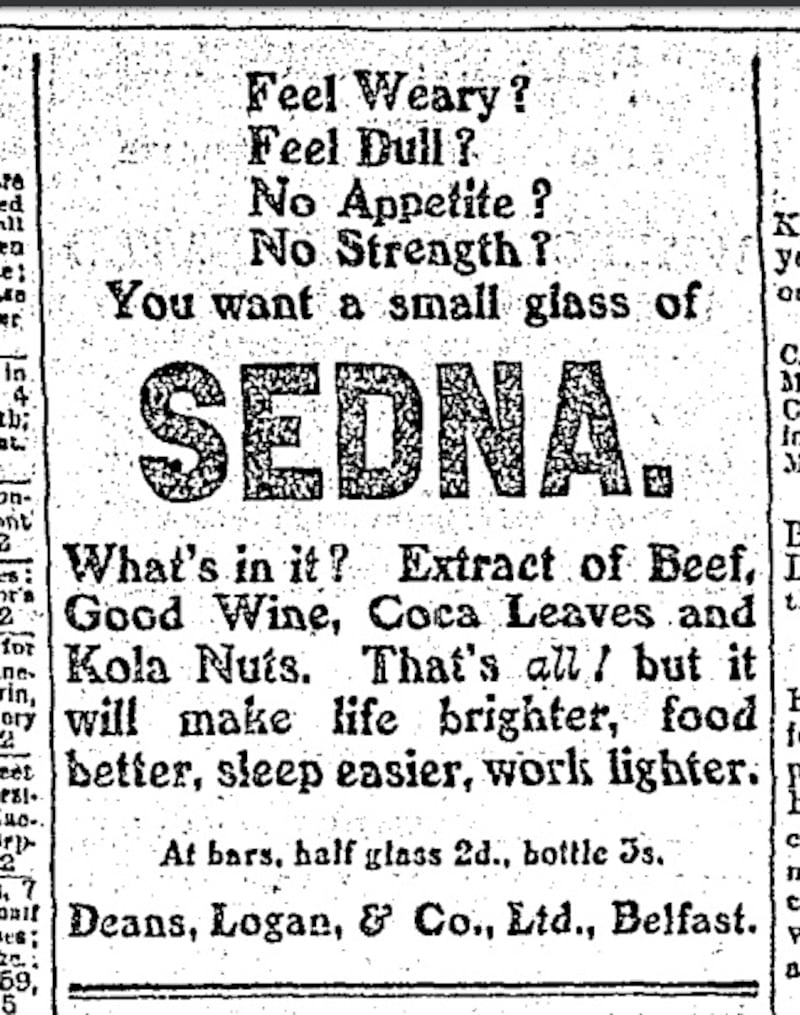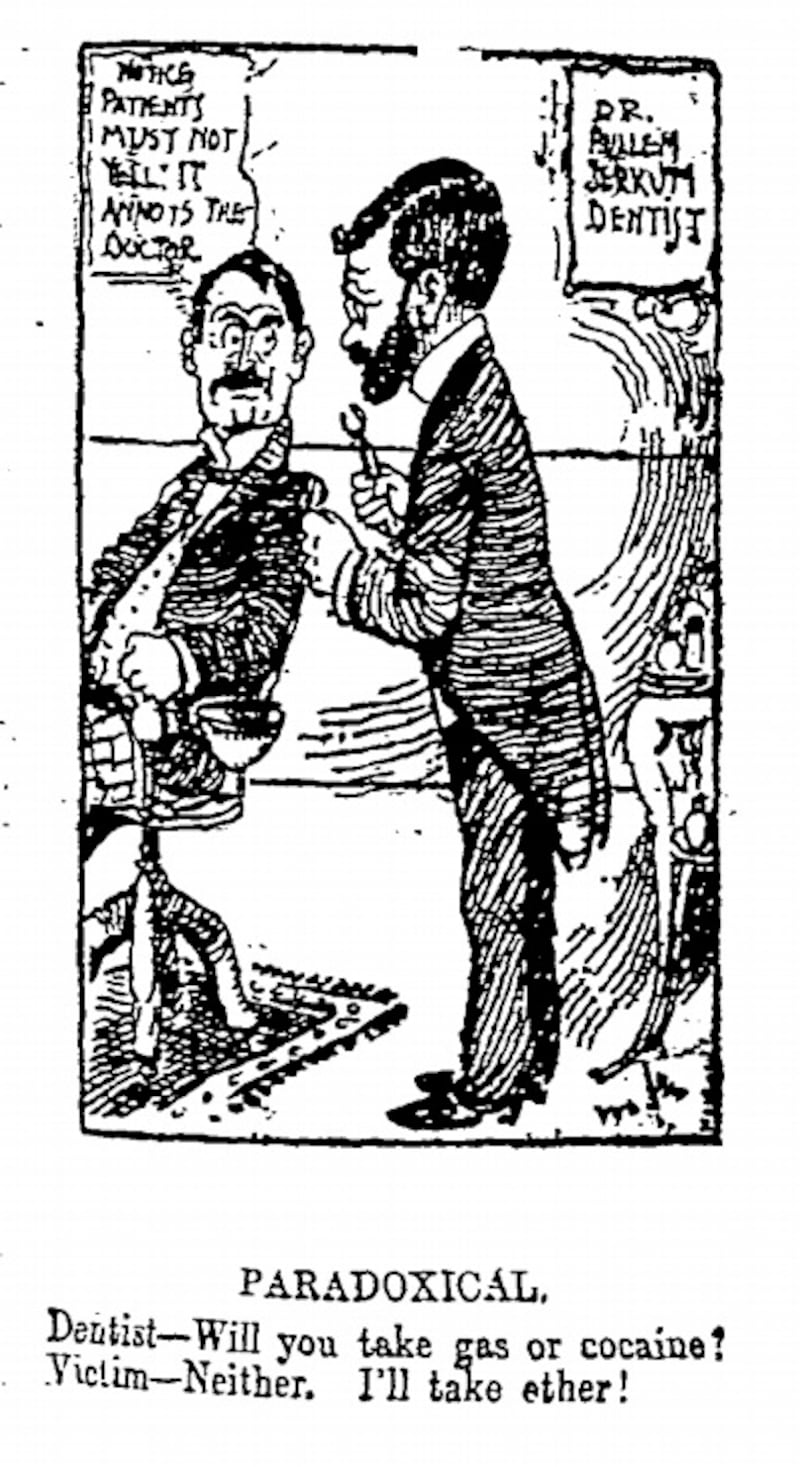When cocaine was first lauded as an anaesthetic in the 1880s, its use as an ingredient in medicines and proprietary “tonics” quickly followed. And until its regulation under the 1920 Dangerous Drugs Act, doctors and chemists issued prescriptions and compiled concoctions for adults – and children – using the narcotic, and its source, the coca leaf.

Many accounts of cocaine use for medical examinations and surgeries appeared in The Irish Times – the German Crown Prince was a recipient in 1888. However, one of the more fascinating reports occurs in 1897, at Dublin's Eye and Ear Hospital. "A pig's eyelid was cut off a fresh slaughtered animal and grafted over the eye of a man named John Ryan. a native of Clonmel. one doctor kept pouring cocaine into the eye, while another staunched the blood."
Dentists were also quick to see the drug's potential. In an 1888 edition, Grafton Street's Dental Supply Company promised "Painless Dentistry", "Gas and Cocaine administered daily", while The Irish-American Dental Surgeons advertised "Painless Extractions by gas or cocaine from 2s 6d".
What may seem surprising is that cocaine's addictive potential was flagged almost immediately. In 1887, at a British Medical Association meeting in Trinity College, Dr N Kerr, president of the Society for the Study of Inebriety, described "inebriety" as a "true intoxication mania", saying it assumed many forms . . . "alcohol, opium, chloral, chloroform . . . ether or cocaine."

The new panacea, however, featured regularly in the paper’s “Household Hints & Recipes” of the late 1880s. It suggests “Cocaine Tooth Powder”, “useful for toothache and spongy gums”, and “Coca for troublesome throats . . . ” , but adds: “To be of any decided value it must be made from the coca leaves. Very much of the coca wine on the market is merely a solution of cocaine, which cannot be too severely condemned.”
Coca Wine had been widely imbibed even before the 1880s. Both Queen Victoria and Pope Pius X were said to enjoy a glass. "La Rochelle's" was one popular brand: "Prepared from Peruvian Coca Leaves. A valuable Stimulating Tonic in cases of debility and for persons recovering from illness, especially in the sleeplessness arising from nervous exhaustion. Price 2s 6D."
In 1897, however, an alarming front page article warned of “Coca Wine and Its Dangers” and decried its increasing consumption as a “source of danger to the national health”.
Readers were told: “School-mistresses, as a rule, have a deep-rooted belief in the efficacy of the popular drug, and give it to their pupils on the slightest provocation, in complete ignorance of the fact that they are establishing a liking not only for alcohol but for the far more insidious and pernicious poison, cocaine.”

Cocaine became a first aid essential. A cycling correspondent, describing preparations for an 1889 journey, recommends: “calendulated vaseline, which suits for the cham or frictional soreness between the legs; . . . Cocaine tabloids, a few safety pins . . . ”
In 1890 "Cocaine Pencils" are proposed for chafed skin,"…an addition of two per cent of cocaine to the ordinary cacoa butter pencils converts the latter into a cosmetic remedy, which gives almost instant relief when rubbed over the irritated spot." And in 1895 when the Prince of Wales gets "something in his eye" while out shooting, the response of an accompanying medic is to administer: "an injection of cocaine".
A front page paragraph in 1894 offers advice for: “Emergency Treatment of a Toothache”: “When the gums are swollen and tender paint two or three times, two minutes apart, with a four per cent solution of cocaine.” Rubbing cocaine into the gums was a popular remedy, but one with possible fatal consequences. In 1895 a vicar tells a Coroner’s Court how his deceased wife, “had suffered much with neuralgic pains in the gums, for which she had occasionally used cocaine as a local anaesthetic.”
As the dispensing of cocaine continued to increase, warnings about its potential harm were sounded. An 1898 article quotes a British Medical Journal description of “cocaine poisoning”, as “the third great scourge of the world, alcohol and opium being the first and second.”
However, the popularity of coca and its offspring didn’t diminish. Sedna was just one much advertised elixir, which claimed to be recommended by doctors. One 1903 ad for this combination of “Port wine, extract of beef, Kola nuts and Coca leaves” described it as: “The magic drink that sends the blood pulsing through the veins, gives you new life, and makes it worth living…”

In 1905, despite being declared a poison by the Council of the Pharmaceutical Society, its use remained widespread. In 1909, a London report discusses the “tonics” being used to pass insurance medicals. One “potent pick-me-up”, is no secret explains a chemist. Under the influence of the coca plant: “…public men have been known to rise from the couch of physical infirmity…The dullest intellect seems to be roused by the stimulant…” However, he warned that these tonics were “dangerous compounds of death”, rather than elixirs of life.
“Medico”, the paper’s health correspondent, also continued to recommend its curative powers. In 1909 reader “Country Mouse”, is advised to: “buy a quarter pound of coca leaves from the chemist’s, and infuse a small handful…in boiling water like tea, let it stand for twenty minutes, and then drink it, either plain or with a little milk and sugar. You will not like it at first, but you will soon become accustomed to it, and even enjoy it, as it is most strengthening and reviving when you feel tired out or weak.”
His 1912 prescription for throat spray, meanwhile, included: 16grs of cocaine, and a 1914 sore nose remedy was “try syringing the nostrils morning and evening with a solution of carbolic and cocaine…”
Meanwhile, when regulations were finally introduced restricting prescriptions, and prohibiting chemists from making compounds using cocaine, they were not universally welcomed. There were objections from doctors, pharmacists and even farmers - who used preparations containing cocaine to treat livestock!
Our correspondent complained: “common preparations were being put behind a screen of red tape, and farmers may be forced to interview their doctors before they can buy a bolus for a cow.”
- This is part of a series looking at the archives of The Irish Times concerning health.
1) Sleeping secrets: undress in the dark
2) Cooking for invalids: wine and champagne
3) Eat fat, no milk: 19 rules of long living
4) Bloody cures for women's periods
5) Electrical cures to revive sluggish functions
6) Your 'flatulence' explain your 'noises'
7) Curing psoriasis with nude sunbathing
8) Weight-loss: Obesity soap and fat massage
9) Institution Dubliners hoped they'd never enter
10) Cocaine Tooth Powder
11) 'Sun-ray' therapy
12) Men's hair products







